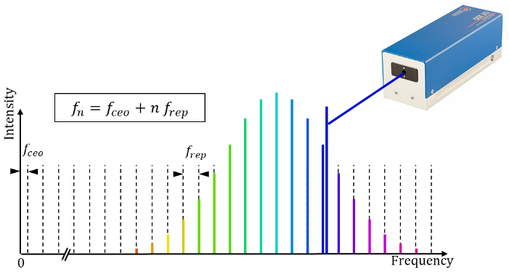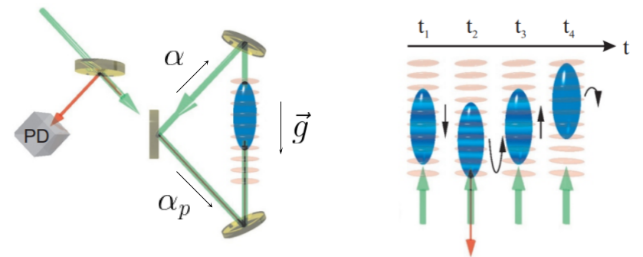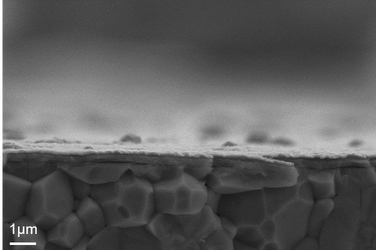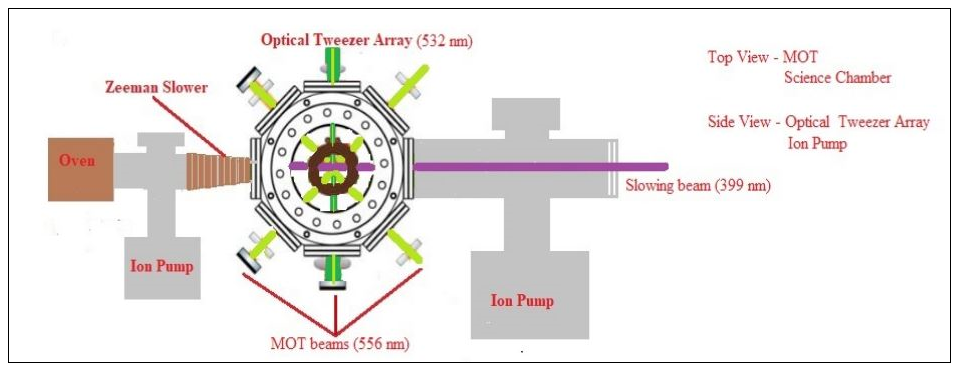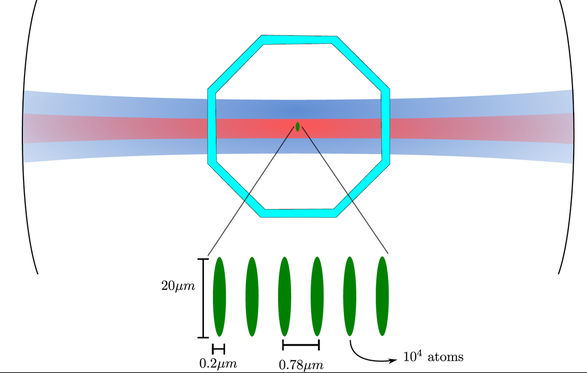Every month, three ESRs from the MoSaiQC ITN have delivered a 15-20 minute presentation in an online webinar about their PhD or Master project. Since the ITN partners are all working on related topics and with secondments and visits planned between the partners in the future, the goal of the webinar is to discover what others are working on and their research background.
The webinars are currently ongoing and on this page you will find a brief summary of every webinar. Would you like to receive more information?
Send an e-mail to the MoSaiQC Project Coordinator (j.e.kreukels@uva.nl).
The webinars are currently ongoing and on this page you will find a brief summary of every webinar. Would you like to receive more information?
Send an e-mail to the MoSaiQC Project Coordinator (j.e.kreukels@uva.nl).
Webinar 1
Julian Robinson-Tait (UCPH) - Master thesis presentation
Broadband Tuning Laser while Phase-Locked to a Frequency Comb
The precise and agile generation of laser light promises to benefit a wide range of current and future applications. This presentation was based on the results from state-of-the-art experiments with an agilely-tunable optical frequency synthesizer (ATOFS). The ATOFS synthesizes wavelengths at 1550nm and can tune coherently and continuously over several THz at THz/s, while also maintaining a hard phase-lock to a frequency comb. These experiments were designed to emphasize the unique qualities ATOFS, for example generating and detecting terahertz frequencies (0.1-3 THz) with precision and stability greater than what could be quantified with available techniques.
Julian Robinson-Tait (UCPH) - Master thesis presentation
Broadband Tuning Laser while Phase-Locked to a Frequency Comb
The precise and agile generation of laser light promises to benefit a wide range of current and future applications. This presentation was based on the results from state-of-the-art experiments with an agilely-tunable optical frequency synthesizer (ATOFS). The ATOFS synthesizes wavelengths at 1550nm and can tune coherently and continuously over several THz at THz/s, while also maintaining a hard phase-lock to a frequency comb. These experiments were designed to emphasize the unique qualities ATOFS, for example generating and detecting terahertz frequencies (0.1-3 THz) with precision and stability greater than what could be quantified with available techniques.
Camila Beli Silva (UvA) - Master thesis presentation
Development of a stable diode laser system for cavity-assisted matter-wave interferometry
This project is part of an experiment that has been developed to probe in a non-destructive method the dynamics of ultracold strontium atoms in a vertical one-dimensional optical lattice sustained by a ring cavity, where they shall perform Bloch Oscillations due to the gravitational potential. A fundamental part of the experiment is the achievement of a laser system with high-frequency stability and narrow linewidth. The project explores the control of the phase and frequency of the radiation emitted by a diode laser, which are essential devices of most atomic physics experiments. Phase and frequency control is achieved by electronic feedback systems, such as the Pound-Drever-Hall technique (PDH), optical phase-locked loops (OPLL), and injection locking.
Development of a stable diode laser system for cavity-assisted matter-wave interferometry
This project is part of an experiment that has been developed to probe in a non-destructive method the dynamics of ultracold strontium atoms in a vertical one-dimensional optical lattice sustained by a ring cavity, where they shall perform Bloch Oscillations due to the gravitational potential. A fundamental part of the experiment is the achievement of a laser system with high-frequency stability and narrow linewidth. The project explores the control of the phase and frequency of the radiation emitted by a diode laser, which are essential devices of most atomic physics experiments. Phase and frequency control is achieved by electronic feedback systems, such as the Pound-Drever-Hall technique (PDH), optical phase-locked loops (OPLL), and injection locking.
Anna Bychev (UIBK)
Many-body dynamics and transport of cold Bose atoms in certain open systems
The presentation is a brief review of the Master thesis studying transport and many-body dynamics of cold Bose atoms. Particular attention is given to an atomic current through a 1D optical lattice connecting two particle reservoirs acting as a source and sink of particles. It is shown that in the presence of interparticle interactions there is a transition from the ballistic transport regime, where the stationary current is independent of the lattice length, to the diffusive regime, where the current is inversely proportional to the lattice length.
Webinar 2
Eliot Bohr (UCPH)
Towards an Ultra-stable reference laser on a kHz wide transition
I give a brief introduction about the importance of having ultra-stable lasers. Then I explain how this is achieved using a high-finesse cavity and the Pound-Drever-Hall technique. I show preliminary results of a beat measurement done between the reference laser and our clock laser. Next I report on the current status and discuss approaches to overcome current limitations in the performance. Lastly, I will mention my secondment work with Iodine in a hollow-core fibre at Denmark’s National Metrology Institute.
Andrea Pertoldi (NKT/UCPH)
Interface Stability of Lithium Garnet Thin Films
Pulses of a high energy laser light can be used to deposit thin layers of materials. In this work, the interface stability of garnet type solid state electrolyte (Li7La3Zr2O12 , LLZO) in thin film form versus metallic lithium was investigated. By tuning the parameters of the pulsed laser deposition process, it is possible to control the lithiation degree in the films and therefore obtain high conducting cubic and amorphous LLZO thin films. Suitable model systems were envisioned to study the electrochemical and surface properties of this new electrolyte material. The results yielded competitive interfacial resistance and critical current density values for the films without evident film degradation. It is therefore suggested that the integration of LLZO thin films in solid state devices could not only feasible, but also outperform current state-of-the-art solid electrolytes.
Many-body dynamics and transport of cold Bose atoms in certain open systems
The presentation is a brief review of the Master thesis studying transport and many-body dynamics of cold Bose atoms. Particular attention is given to an atomic current through a 1D optical lattice connecting two particle reservoirs acting as a source and sink of particles. It is shown that in the presence of interparticle interactions there is a transition from the ballistic transport regime, where the stationary current is independent of the lattice length, to the diffusive regime, where the current is inversely proportional to the lattice length.
Webinar 2
Eliot Bohr (UCPH)
Towards an Ultra-stable reference laser on a kHz wide transition
I give a brief introduction about the importance of having ultra-stable lasers. Then I explain how this is achieved using a high-finesse cavity and the Pound-Drever-Hall technique. I show preliminary results of a beat measurement done between the reference laser and our clock laser. Next I report on the current status and discuss approaches to overcome current limitations in the performance. Lastly, I will mention my secondment work with Iodine in a hollow-core fibre at Denmark’s National Metrology Institute.
Andrea Pertoldi (NKT/UCPH)
Interface Stability of Lithium Garnet Thin Films
Pulses of a high energy laser light can be used to deposit thin layers of materials. In this work, the interface stability of garnet type solid state electrolyte (Li7La3Zr2O12 , LLZO) in thin film form versus metallic lithium was investigated. By tuning the parameters of the pulsed laser deposition process, it is possible to control the lithiation degree in the films and therefore obtain high conducting cubic and amorphous LLZO thin films. Suitable model systems were envisioned to study the electrochemical and surface properties of this new electrolyte material. The results yielded competitive interfacial resistance and critical current density values for the films without evident film degradation. It is therefore suggested that the integration of LLZO thin films in solid state devices could not only feasible, but also outperform current state-of-the-art solid electrolytes.
Swadheen Dubey (TUW)
Study of BEC and RF dressed state potentials.
In my Master thesis I performed a theoretical study of BEC in magnetic traps and radio frequency dressed state potential. In the first half of my thesis, I studied the theory of BEC, elementary excitation associated with condensate, and how one realizes a BEC with Rb atoms. In the second half, I explored the RF-dressed state potential and how one can produce a double-well, a ring trap, and in general polarization-dependent potentials. RF-dressed state potentials are controlled by RF amplitudes, RF detuning, and RF polarization state. So, I explored how to make more precise calculations of RF dressed state potential for a Bose-Einstein Condensate trapped in a magnetic trap.
Study of BEC and RF dressed state potentials.
In my Master thesis I performed a theoretical study of BEC in magnetic traps and radio frequency dressed state potential. In the first half of my thesis, I studied the theory of BEC, elementary excitation associated with condensate, and how one realizes a BEC with Rb atoms. In the second half, I explored the RF-dressed state potential and how one can produce a double-well, a ring trap, and in general polarization-dependent potentials. RF-dressed state potentials are controlled by RF amplitudes, RF detuning, and RF polarization state. So, I explored how to make more precise calculations of RF dressed state potential for a Bose-Einstein Condensate trapped in a magnetic trap.
Webinar 3
Mehrdad Zarei (UMK)
Functional Near-IR Spectroscopy (fNIRS)
Mehrdad explained the principle of Functional Near-IR Spectroscopy (fNIRS). The fNIRS is a method for monitoring the brain that is non-invasive, relatively cheap, and portable. In this method visible and near-IR light enters the head tissue and during passes of curved path come back to the surface. When light travels this path some part of them absorbed by chromophores in the cortex layer. The absorption coefficient on the cortex, changed by stimulated or activation that somebody does, so if we investigate the detected optical intensity change, we will find the trend of concentration change of two main chromophores in absorption wavelength.
Mehrdad Zarei (UMK)
Functional Near-IR Spectroscopy (fNIRS)
Mehrdad explained the principle of Functional Near-IR Spectroscopy (fNIRS). The fNIRS is a method for monitoring the brain that is non-invasive, relatively cheap, and portable. In this method visible and near-IR light enters the head tissue and during passes of curved path come back to the surface. When light travels this path some part of them absorbed by chromophores in the cortex layer. The absorption coefficient on the cortex, changed by stimulated or activation that somebody does, so if we investigate the detected optical intensity change, we will find the trend of concentration change of two main chromophores in absorption wavelength.
Abhilash Kumar Jha (UoB)
Development of an experimental set-up for programmable quantum system using cold Ytterbium Rydberg atoms
Alkaline earth (like) atoms provide a unique platform for implementation of quantum information processing in Rydberg atom quantum many body systems. The scope of Abhilash’ master thesis was to develop an experimental set-up for a programmable quantum system using cold Ytterbium Rydberg atoms. This presentation provided a brief summary of results of main objectives of the master thesis which were:- 1) Development of a 507 nm frequency stabilized laser system for transition of 171Y b atom from 1S0 ground state to 3P2 metastable state, 2) Development of Optical tweezers array towards deterministic single atom loading, 3) Installation of our new windows into the science chamber and restoring vacuum.
Development of an experimental set-up for programmable quantum system using cold Ytterbium Rydberg atoms
Alkaline earth (like) atoms provide a unique platform for implementation of quantum information processing in Rydberg atom quantum many body systems. The scope of Abhilash’ master thesis was to develop an experimental set-up for a programmable quantum system using cold Ytterbium Rydberg atoms. This presentation provided a brief summary of results of main objectives of the master thesis which were:- 1) Development of a 507 nm frequency stabilized laser system for transition of 171Y b atom from 1S0 ground state to 3P2 metastable state, 2) Development of Optical tweezers array towards deterministic single atom loading, 3) Installation of our new windows into the science chamber and restoring vacuum.
Sandhya Ganesh (UoB)
Modelling spin-1 Rb-87 Bose-Einstein condensate to study ground states under inhomogeneous magnetic files
Precision studies of Rb87 spinor Bose Einstein Condensate quantum dynamics with non-demolition measurements provide opportunities for understanding fundamental physics of low temperature systems and explore its applications in high resolution magnetic field sensing. A cavity enhanced detection of the magnetization in the cold atomic ensembles provide pathways for magnetometry with the spinor condensate, with the ensemble magnetization being the preserved observable for the quantum non-demolition measurements. This cavity enhancement results in the ’pancake’-shaped condensates in an optical lattice. Studying the ground states of such pancake condensates serve as the starting point for understanding variety of phenomena such as low-energy dynamics, spin textures, effects of magnetic dipole interactions. The aim of this Master's thesis is to develop a computational framework using numerical methods to simulate the ground state solutions of a F=1 hyperfine manifold of Rb87 Bose-Einstein Condensate by solving multi-component Gross-Pitaevskii equation. We study the mean-field ground states under external bias magnetic fields and in the presence of the field generated due to ensemble magnetic moments.
Modelling spin-1 Rb-87 Bose-Einstein condensate to study ground states under inhomogeneous magnetic files
Precision studies of Rb87 spinor Bose Einstein Condensate quantum dynamics with non-demolition measurements provide opportunities for understanding fundamental physics of low temperature systems and explore its applications in high resolution magnetic field sensing. A cavity enhanced detection of the magnetization in the cold atomic ensembles provide pathways for magnetometry with the spinor condensate, with the ensemble magnetization being the preserved observable for the quantum non-demolition measurements. This cavity enhancement results in the ’pancake’-shaped condensates in an optical lattice. Studying the ground states of such pancake condensates serve as the starting point for understanding variety of phenomena such as low-energy dynamics, spin textures, effects of magnetic dipole interactions. The aim of this Master's thesis is to develop a computational framework using numerical methods to simulate the ground state solutions of a F=1 hyperfine manifold of Rb87 Bose-Einstein Condensate by solving multi-component Gross-Pitaevskii equation. We study the mean-field ground states under external bias magnetic fields and in the presence of the field generated due to ensemble magnetic moments.
Webinar 4 is planned for June 2021.

